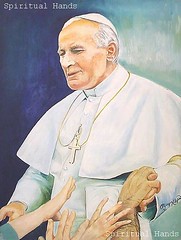The Procedure Of Electing The Next Pope
An amazing article on how the next pope will be elected. This article appeared in Rediff.com. Click on the headline to go to Rediff's web site.
The Procedure Of Electing The Next Pope

When the Pope dies, the administrator of the property and the revenues of the Holy See -- who is known as Cardinal Camerlengo -- first verifies the Pontiff's death. This is done by striking the Pope's forehead gently thrice with a silver hammer and asking him, using his Baptismal name, whether he is dead.
If there is no response from the Pope, the Camerlengo solemnly announces his death. He then removes the ring from the dead Pope's finger. This ring, along with the papal seal, is broken, and the Pope's bedroom and study are sealed.
Then follows a nine-day period of mourning, known as novemdiales, during which novenas are said and the Camerlengo (who is now in charge of the Church until a new Pope is elected) arranges the funeral.
The Camerlengo soon calls a Conclave of Cardinals who will meet in the Sistine Chapel in the Vatican. The Conclave now consists of 115 Cardinal electors, who elect the Pope in utmost secrecy.
In fact, the Cardinals were at one time literally locked in the Sistine Chapel, where the voting takes place; nowadays they are allowed to sleep in special apartments.
Upon entering the Conclave, the Cardinals take an oath of secrecy; the penalty for breaking the oath is automatic excommunication.
The secrecy of the Conclave is very important and serious. The Cardinals cannot communicate with anyone in the outside world when the election is on; even windows are painted over so the Cardinals cannot see the world outside.
The election process generally begins between 15 and 20 days after the Pope's death.
The Cardinals are given paper ballots inscribed with the words, 'I elect as Supreme Pontiff' with a blank area for them to write their preference. Each Cardinal in order of seniority places these ballots on the altar.
These ballots are read aloud first by the Camerlengo. If no person has received a two-thirds vote, there is another vote. If still no Pope has been elected, the ballots are burnt along with straw so that the smoke is black; if a Pope has been elected, the paper is burned alone so that the smoke is white.
If after voting for three days, no Pope has been elected, a day is taken for discussions, rest and prayer. Then voting resumes. If seven more days pass with no decision, there is another day of rest and prayer.
Another series of seven ballots is held, followed by another day of rest and prayer, if necessary.
Then again, another series of seven ballots is held. At this point, if still no Pope is elected, they may elect a Pope by absolute majority (50%+1 instead of the two-thirds majority) or decide to vote only on the two candidates who ranked first and second in the most recent tally.
The Procedure Of Electing The Next Pope

When the Pope dies, the administrator of the property and the revenues of the Holy See -- who is known as Cardinal Camerlengo -- first verifies the Pontiff's death. This is done by striking the Pope's forehead gently thrice with a silver hammer and asking him, using his Baptismal name, whether he is dead.
If there is no response from the Pope, the Camerlengo solemnly announces his death. He then removes the ring from the dead Pope's finger. This ring, along with the papal seal, is broken, and the Pope's bedroom and study are sealed.
Then follows a nine-day period of mourning, known as novemdiales, during which novenas are said and the Camerlengo (who is now in charge of the Church until a new Pope is elected) arranges the funeral.
The Camerlengo soon calls a Conclave of Cardinals who will meet in the Sistine Chapel in the Vatican. The Conclave now consists of 115 Cardinal electors, who elect the Pope in utmost secrecy.
In fact, the Cardinals were at one time literally locked in the Sistine Chapel, where the voting takes place; nowadays they are allowed to sleep in special apartments.
Upon entering the Conclave, the Cardinals take an oath of secrecy; the penalty for breaking the oath is automatic excommunication.
The secrecy of the Conclave is very important and serious. The Cardinals cannot communicate with anyone in the outside world when the election is on; even windows are painted over so the Cardinals cannot see the world outside.
The election process generally begins between 15 and 20 days after the Pope's death.
The Cardinals are given paper ballots inscribed with the words, 'I elect as Supreme Pontiff' with a blank area for them to write their preference. Each Cardinal in order of seniority places these ballots on the altar.
These ballots are read aloud first by the Camerlengo. If no person has received a two-thirds vote, there is another vote. If still no Pope has been elected, the ballots are burnt along with straw so that the smoke is black; if a Pope has been elected, the paper is burned alone so that the smoke is white.
If after voting for three days, no Pope has been elected, a day is taken for discussions, rest and prayer. Then voting resumes. If seven more days pass with no decision, there is another day of rest and prayer.
Another series of seven ballots is held, followed by another day of rest and prayer, if necessary.
Then again, another series of seven ballots is held. At this point, if still no Pope is elected, they may elect a Pope by absolute majority (50%+1 instead of the two-thirds majority) or decide to vote only on the two candidates who ranked first and second in the most recent tally.


0 Comments:
Post a Comment
<< Home